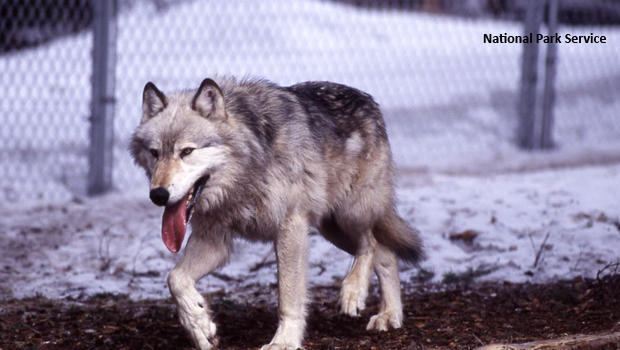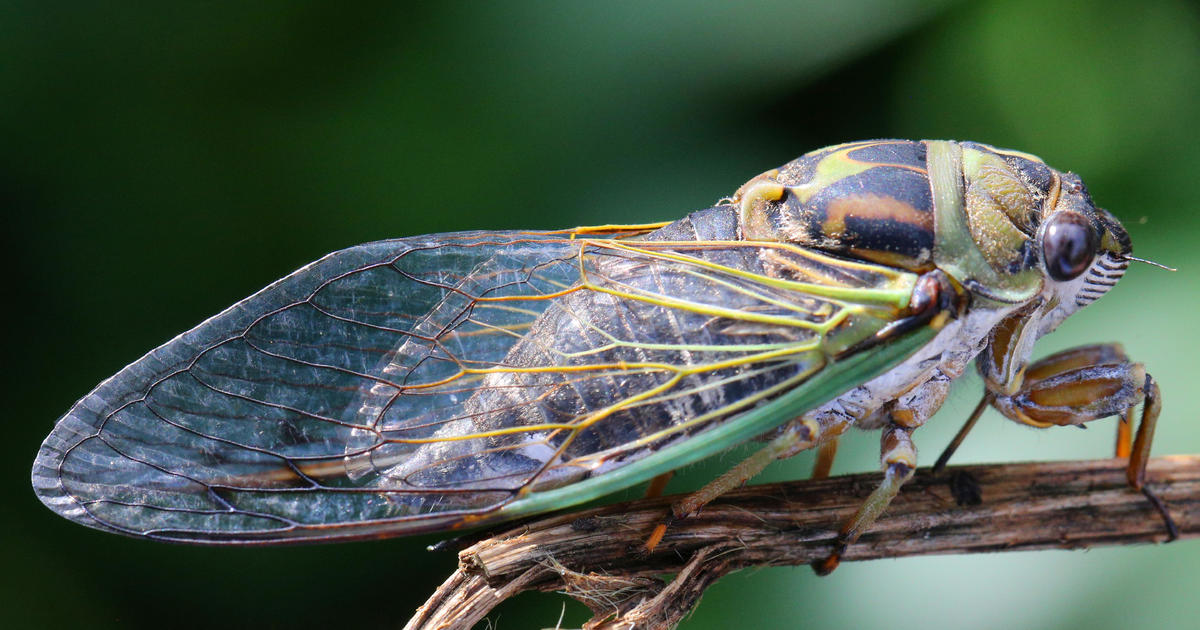Nature up close: The best wolf ever
"We reached the old wolf in time to watch a fierce green fire dying in her eyes. I realized then and have known ever since that there was something new to me in those eyes, something known only to her and to the mountain. I was young then and full of trigger-itch; I thought that because fewer wolves meant more deer, that no wolves would mean hunters' paradise. But after seeing the green fire die, I sensed that neither the wolf nor the mountain agreed with such a view." – Aldo Leopold, "A Sand County Almanac" (1949)
I want to tell you a story of love, triumph, loss, and redemption. I want to tell you a story about a wolf. I learned to recognize the wolf known as 21M (M for male) like you recognize a brother or favorite uncle – you just know it's him. He was the alpha male of the Druid Peak Pack when the Druids ruled Lamar Valley in Yellowstone National Park. He was a rock star, and I was a groupie, a wolf groupie!
Although exact numbers will never be known, it is estimated there were at least 400,000 grey wolves in what is now the lower 48 states when Europeans arrived, but by 1930 that number was very close to zero, including in Yellowstone.
The oldest national park in the world originally didn't have any rules to protect its natural features and wildlife, especially wolves. In its early days hunting was allowed. At the time we had "Little Red Riding Hood" syndrome; the only good wolf was a dead wolf. Many people believed fewer wolves meant more deer, elk and moose. By 1926 wolves were completely extinct in Yellowstone, as well as most other parts of the U.S. Think of that – from over 400,000 to essentially zero in about 250 years.
In 1973 the Endangered Species Act was passed, and grey wolves were one of the first species to be place on the list as endangered in the lower 48. People began to talk about reintroducing wolves into western states, especially Yellowstone. It took years, but they finally won.
After numerous court battles, wild wolves were collected in Canada, put into large crates, and carefully taken to Yellowstone, as well as several locations in Idaho. The Idaho wolves were given a hard release – their crates were opened and they were left to fend for themselves. Some made it, but not all.
The Yellowstone release was different; it was one of the most brilliantly thought-out releases imaginable. Wolf experts recommended capturing wild Canadian wolves from a variety of locations, so genetic diversity would be high, and then placing them in large fenced enclosures during wolf mating season in Yellowstone's Lamar Valley. The hope was the wolves would mate and could then be released when the females were pregnant and had a strong denning instinct, so they would not try to return to Canada.
In early 1995 the Canadian wolves were captured and brought into Yellowstone, on January 12, through the Roosevelt Arch. School kids and other well-wishers lined the road on that cold morning. I was teaching in Texas at the time, but my spirit was on the side of that road, cheering them on. I've watched a video of that moment many times. I still get choked up when I see it. The wolves were finally coming home! The hope was that wolves who had never met each other would successfully form packs, establish an alpha male and female, and (best-case scenario) the alpha female would get pregnant.
The wolves were released into the enclosures and road-killed bison and elk were brought to the enclosures, not just as food, but as a lesson in what was available in the park to hunt once they were released.
The wolf experts crossed their fingers and waited.
The results were better than almost anyone hoped for. All three groups formed packs, complete with an alpha male and female, and even more remarkably, all three alpha females got pregnant.
To help insure the wolves would stay in Yellowstone the wolf management team waited until late March to open the gates on the enclosures when the females where ready to den. Except they didn't come out! The smell of humans was too strong. After several days, the wolf project employees went to the back of the enclosures and cut holes in the fence. The wolves were still reluctant, but they finally came out, dug dens and had their pups.
I was watching all of this from Texas, and was dying to go to Yellowstone. I talked my husband into flying to the park during our spring break in early March. I had no expectations of seeing a wolf since they were still in their pens; I just wanted to be near them. We went to the Lamar Valley, saw a bunch of skinny bison, and I had my picture taken with the wagon the wolf project used to bring bison, elk, deer, etc., to the penned wolves. I was thrilled! The wolves were finally back where they belonged, and everything would be fine.
To watch Tracy Smith's 2007 CBS News report on wolves in Yellowstone, click on the video player below.
Once the wolves were released we (along with thousands of other people) began to spend a lot of time in the Lamar Valley watching them. I was a fanatic wolf watcher then. I almost never had a camera, but always had my binoculars or a spotting scope. Back then I couldn't tell one wolf from another, except for 21.
He did not have a promising beginning. When the wolves were first released in 1995, number 9 and number 10 (the alpha female and male of the Rose Creek Pack, respectively) left the park. While number 10 was out hunting, number 9 gave birth to 8 pups beneath a pine tree. A guy from Red Lodge, Montana, shot and killed number 10. All of the newly-introduced wolves had radio collars, so finding the hunter was not difficult, especially since he brought the radio collar home with the dead animal.
With number 10 dead, the wolf project worried that number 9 could not hunt for herself, and she was well outside the park with what was now almost one-third of the new Yellowstone wolf population. With the aid of her radio collar they finally found her, and her pups, and took them back to their original enclosure so they could bring food to her.
Then in August, another near-disaster occurred when trees fell on part of the enclosure, allowing the uncollared pups to escape. Some of them were recaptured, and the rest were fed outside the enclosure. The downed trees may have been a good thing in the long term, as it allowed some of the pups to meet wolf 8M, a sub-adult male from a different enclosure who left his pack and eventually became the new alpha male of the Rose Creek Pack.
One of number 9 and 10's pups, 21, would become the most famous and loved wolf of all time in Yellowstone. 21 grew up to become the alpha male of the Druid Peak Pack.
Normally, a wolf pack has one alpha male and one alpha female, and only the alpha female is allowed to mate. After 21 became the alpha of the Druids, he forgot to read the manual, and got three females pregnant – the alpha female, 40; her sister, 42; and a third, unrelated pack female. Number 40 denned in what has become one of the most heavily-used wolf dens in Yellowstone, slightly northeast of the confluence of the Lamar River and Soda Butte Creek. One of the females denned about seven miles away, near Slough Creek. Number 40 ruled with an iron paw. She was very aggressive to her subordinates, especially her sister. One night her sister, who had evidently had enough, and maybe another female, killed her. Although no one that cares about wolves would think that is a good thing, it did indeed turn out to be advantageous. The Druids were a small pack and they never would have been able to provide for 21 growing puppies in three separate dens. When Number 42 became the alpha female, all the pups were moved to the main den northeast of the confluence, and that year, 2000, 21 and his pack raised 21 pups. The following year they raised ten pups, making the Druids, with 37 wolves, the largest wolf pack ever recorded.
Those were the heydays for wolves – and wolf watchers – in Yellowstone. A wolf whose dad was killed just as he was being born grew up to lead a pack of 37, and lead it with strength and intelligence. 21 was not an aggressive leader. He rarely picked a fight with other wolves, and although he successfully defended their territory (sometimes in fights where he was outnumbered six to one), he never killed another wolf. He was a great provider, and he loved to play with his pups. A model wolf in every way!
By 2004 the Druids' numbers had declined, and in June of that year 21 was found dead of natural causes under a tree overlooking Lamar Valley at the relatively old wolf age of ten. By 2010 there was only one living Druid, a female with mange who was shot and killed by a rancher near Butte, Montana. (Mange is deadly to wolves and she was starving.)
Wolves in the northwestern U.S. are now off the Endangered Species List, and there is a legal hunting season for wolves in Idaho, Wyoming and Montana. The Yellowstone wolf population has never been as high as it was when the Druids ruled the Lamar but they've hung on. Not only have they hung on throughout the Greater Yellowstone ecosystem (Yellowstone, the Tetons and all of the National Forest land surrounding both parks), but the Lamar Valley has changed for the better. Because wolves hunt primarily elk their numbers have declined and many other organisms have benefited. Beavers are back in both the Lamar River and Soda Butte Creek. There are more aspens in the valley. Coyotes, who had never seen a wolf before 1995, declined, so fox and pronghorn numbers are up. Fewer elk have also meant more cottonwoods and willows, which has meant an increase in moose and songbirds, and less erosion along the creeks and rivers. And all of the scavengers (like ravens, magpies, bald eagles, bears and even coyotes) have benefited. Most importantly, the Greater Yellowstone Ecosystem is now the largest, most intact ecosystem in the lower 48 states. All the parts are there, from the predators to the algae and bacteria.
No one knows exactly how many wolves are in the lower 48 states now. Estimates range from around 3,500 to almost 6,000. Those numbers are still a very small percentage of the origin estimate of 400,000. How many wolves is enough? How many are too many? Is there such a thing as too many wolves?
See also:
- Wolves: Yellowstone National Park (NPS)
- Yellowstone Wolf Project (Yellowstone Forever)
Judy Lehmberg is a former college biology teacher who now shoots nature videos.
For more info:
- Judy Lehmberg (Official site)
- Judy Lehmberg's YouTube Channel
To watch extended "Sunday Morning" Nature videos click here!





